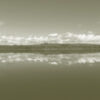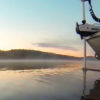Australian Bass (Macquaria novemaculeata)
Australian Bass do not breed in fresh water impoundments as they require access to brackish water. In the wild male fish tend to hold downstream in these brackish water areas with the females remaining upstream in the fresh. During winter (May to August) Bass make a spawning run downstream to access this brackish water for breeding. Bass populations in impoundments have to be continually restocked to maintain them.
Bass can live for more than 15 years and reach a maximum size of around 60cm and 4kg although are more commonly caught up to 40cm
Angling Hints
Australian Bass are a aggressive feeder and as such make a great prospect for a fishing target. Bass will readily take lures as well as baits, Fresh and local baits work best for Bass but by far the best if the freshwater shrimp. Bass will take a wide range of lures from hard bodies to spinnerbaits and soft plastics.
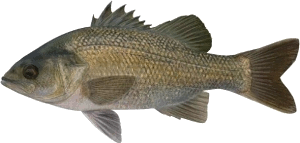
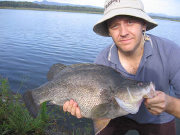
Golden Perch (Yellow Belly) (Macquaria ambigua)
Golden Perch are highly unlikely to successfully spawn and recruit in our impoundments and as such restocking is the only method of effectively maintaining a sizeable population for anglers to target. Impoundment stocked fish have proven to be fast growing, often reaching legal size within 12 months of release. Impoundment reared Golden Perch will reach over 10kgs with the right conditions although a fish of 5kgs is normally considered better than average.
The colour range for this fish is from bronze-olive through to gold-yellow to almost completely white. They are probably the best of our fresh water table fishes, having a firm white flesh and usually no muddy taste. They do however retain a layer of fat which is easily removed during the filleting process.
Angling Hints
Golden Perch are readily caught on most local baits such as earthworms and local shrimp. Fish a line class of 4 – 5kg with a simple rig of a ball sinker, swivel and trace of approximately 30cm attached to a no. 2 to no. 2/0 hook.
Golden perch will also bite very well on lures and spinnerbaits. They will often follow a lure right to the bank before crunching it and then testing your angling ability. And just occasionally they leave the 3-5 meter depth in which they are located and can be found cruising the edge of the weed beds.
September/October and December/January are considered to be the most favoured months to catch Goldens as these months coincide with their natural spawning cycles in riverine environments. These months when combined with a rising barometer is the time when anglers are most likely to produce good catches. Of course, the more astute Golden anglers also study the moon cycle.
Rocky shorelines with deep water access, and the edge of weed banks are the preferred locations for fishing. if using lures try to find an area with a steep drop off to allow your lure to run freely for your full retrieve. When fishing the weed beds, fish on the windward side of the lake. Although it is more comfortable on the other side, the wave action caused by the wind on the weeds provides forage and attracts the bigger fish. This side of the lake also tends to be warmer and it is believed the wave action makes the water more oxygenated and therefore the fish more active.
Saratoga (Scleropages leichardti)
The Saratoga is the only true Australian freshwater fish. All others are marine species which have made the transition to freshwater over time. Saratoga may breed in the both of the lakes, although it appears Lake Kurwongbah will prove to be better suited for breeding over time. Saratoga are readily distinguishable by their colours, sleek body shape, upturned head and barbels on their lower jaw. The magnificent colours of this fish are olive green on top fading to bright silver below, with each of its large scales having 1 – 3 bright orange red spots.
Angling Hints
Saratoga usually feed on insects, forage fish, shrimp and frogs and will readily take a variety of baits, lures and flies, but, because of their primitive hard bony mouths, are hard to hook. Once hooked, however, they provide absolutely spectacular sport, leaping clear of the surface repeatedly and fighting hard.
A light rod and reel combination as used for most other species is quite adequate when fishing for Saratoga. The most important part is to ensure that your hooks are ultra sharp to enable them to lodge in that hard bony mouth.
The warmer summer months are preferred as this is the more active feeding months. The early mornings and late afternoons are the preferred fishing times during the day. Focusing around the edges of weed beds is the accepted method to target these fish. Captures of Saratoga at Lake Samsonvale are intermittent at best and we are not expecting Lake Kurwongbah to come on line as a recognised Saratoga fishery before 2015. If all anglers carefully return any captured fish to the lake as quickly as possible we will have the best chance to develop a strong breeding population.
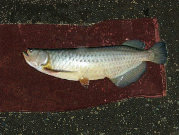
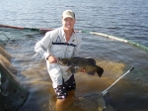
Mary River Cod (Maccullochella peelii mariensis)
Mary River cod were once plentiful in the Mary River System and were possibly the same species of Fresh Water Cod that used to inhabit most river systems in Southeast Queensland. However overfishing and urban, agricultural and industrial development has reduced the natural range to the Mary River System, with this magnificent fish now being classed as an endangered species. These huge, elongated, large-mouthed fish have a protruding lower jaw and are mottled in colours that can include gold, yellow, green or brown with dark spots. They have been officially recorded to around 20kg and anecdotal evidence suggests captures of fish to 40kg in the Mary River used to occur.
Both lakes are stocked as part of the Mary River Cod Conservation Program. Fingerlings (50mm) are purchased from DAF accredited fish hatcheries and it is hoped the Mary River Cod may breed in our impoundments although without suitable breeding structure and a reasonably steady water level during October/November it may be difficult.
Some anglers treat the pastime or sport of fishing as if it is a religion, that being the case, I would just like to finish by saying, “I believe in Cod”.
Angling Hints
Mary River Cod will eat freshwater shrimp, fish, crayfish, rodents, lizards and birds during feeding times. Cod can therefore be tempted by fishers using baits such as live shrimp. Surface lures and large flies are worth a try early morning or late afternoon, but heavy gear is recommended when fishing around the snags and cover that cod prefer.
Large deep-diving lures cast or trolled at a very slow speed can be effective particularly if they have a wide action. Braided lines of at least 10lb are recommended for trolling with many successful anglers preferring 20lb strain and higher in order to turn the fish as quickly as possible when near structure.
Mary River Cod are attracted to shady and protected areas such as rocks, overhanging banks, snags, deep holes, boulders and submerged logs. Trolling through submerged timber has the potential to produce a cod but make sure you have a lure retriever handy to stop this becoming an expensive exercise.
Cod are naturally territorial but move downstream in Autumn and upstream in summer when observed in estuary systems. Not a great deal is known concerning the movement patterns in our lakes yet. They tend to move around to hunt mostly at night and are less likely to be caught in shallow open water during daylight hours, but it is possible that some of the upstream reaches and deeper holes could harbour cod and areas offering the fish plenty of cover may be worth exploring.
While one Mary River Cod per person may be kept from a fishing session at Lake Samsonvale or Kurwongbah, have a think about the relative rarity of these fish before you do. Releasing one of these beauties and watching it disappearing slowly back to the depths with each slow beat of its paddle like tail can be very enjoyable. It may even be argued that it’s good for your soul, particularly if you too, believe in Cod.
Silver Perch (Bidyanus bidyanus)
As the name suggests, these fish are a silver colour with an olive green back. The scales have a dark edge giving the fish a fine netted appearance. Silver perch are related to the tropical Sooty Grunt family and somewhat underrated as a table fish. The flesh is firm and white.
Silvers grow to 7kg in impoundments, however a fish of 2kg is considered to be a good catch. They fight doggedly and are a good sport fish.
Angling Hints
Silver Perch will take a wide range of baits but prefer worms or local freshwater shrimp. They will rise readily to many different types of flies and lures, from blade spinners to deep diving minnows. When bait fishing, a simple rig of a small ball or bean sinker, swivel and a no. 6 to no. 1 hook on the end of a 30cm trace on 3kg line and a light rod is all that is required.
Silver Perch can be very fickle to catch though. Sometimes refusing all but one particular bait and other times feeding voraciously. When targeting Silver Perch, try fly or float fishing with live insects (such as grasshoppers) beside the reed beds or weed/lilly banks at dusk on hot still afternoons. The other most reliable method is fishing the deeper water on overcast days when a light wind ripples the surface.
Silver Perch are a schooling fish and several fish can be taken before they move on. They prefer shallower water than golden perch as a rule, but can turn up anywhere and finding them can take a little work.
Although the flesh is considered by some to be a little dry when compared to golden perch this can overcome by the addition of a sauce. Silver Perch are also an ideal fish for smoking. Check out the Lake Samsonvale stocking history, it may just be worth your while to target one of these fish.
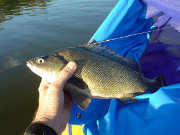
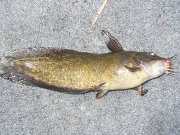
Eel Tail Catfish (Tandanus tandanus)
A fish widely available to shore based anglers and has survived the onslaught of Tilapia in Kurwongbah and in no apparent danger of being over fished in Samsonvale. With its whiskery mouth and eel like tail it is a very easily identifiable fish. Despite its looks it is a very good table fish providing firm white flesh.
Tandanus can grow to a weight of 7 kilograms but is more commonly caught around the 1 – 1.5 kilograms. The body colourations vary from olive-green to yellow-brown sometimes having a striking mottled effect. It is truly one of Australia’s more spectacular looking fresh water fish.
Angling Hints
Tandanus will take almost all freshwater baits including worms, mussels and local freshwater shrimp. A 3 to 4kg line on a light rod is more than adequate to catch this species. There is a couple of terminal rigs commonly used when fishing for Tandanus. The first is a small ball sinker, swivel and 30cm trace; the second (used when the bottom is very silty or weedy) is suspend the bait just off the bottom under a pencil float. The hooks and bait used for both methods are the same and the hook size should be in the no.2 to no.2/0 range.
Tandanus have been known to take lures but it is commonly thought that this is only when aggressively guarding their nest.
Catfish are caught all year round from the shoreline, but do fish well after a rain and there is water inflow to the Lakes. Tandanus nest in fairly shallow water, so you do not have to cast a long distance to catch fish.
When handling a Tandanus be very wary of the long sharp spines on the dorsal and pectoral fins. These spines can inflict a very painful wound and are strong enough to puncture some footware. If you are not intending on keeping a Tandanus for food, always carefully release it back to the water way, as even a dead Tandanus can cause a painful wound if stepped on.
Tandanus are very slippery to handle and are best skinned. To prepare fillets for cooking first soak them overnight in a brine solution (approx. 1 teaspoon of salt per litre of water) stored in your fridge.
Snub-nosed Garfish (Arrhamphus sclerolepis)
Snub-nosed Garfish were introduced into Lake Samsonvale and subsequently Lake Kurwongbah from stock that occurred naturally in Lake Wivenhoe. A self-sustaining population of this baitfish is now established at Lakes Samsonvale and Kurwongbah and it is quite common to witness schools of these fish splashing on the surface.
These small and slender fish can grow as long as 40cm but are commonly seen in the 20 – 30cm range in both lakes. Their preferred diet is aquatic weeds but will consume zoo and phytoplankton when the main source of food becomes scarce. Gar’s preferred dietary habit means they can often be found in and around the margins of weed banks close to the shore line making them a great shore based fishing opportunity.
We believe Gar to be a relatively short lived species although they exhibit a very high fecundancy to make up for it. Initially less than 300 were released into Samsonvale during the late 90s, today estimated numbers exceed well over a 100,000.
Angling Hints
Garfish can be targeted in a number of ways however the following method is the most reliable:
Rig – 4lb line, quill float and no.12 to 16 size hook with no sinker (The Tackle Store at Carseldine is the only place local that always carries this range of tackle)
Burley – Mix some water with slices of bread and mash up to a fine slurry. Take a handful, squeeze off excess water and throw it where you will be fishing. Do a couple to start and one every 5 minutes until the gar school up. Once the bite starts you will only need some infrequently to hold the fish. Too much and you can make it difficult to catch them.
Conditions – Still conditions or a light breeze is best, the gar will still bite with a wind blowing up to around 15 knots. You are best to find a place to fish where the wind is at your back.
Time – Gar are an all day proposition if conditions are right. Although they can be caught year round they are easier to target during the warmer months. We are unsure but it appears that immediately after a large inflow this species will shut down.
Bait – Gar will take a range of baits including bread or Freshwater shrimp.
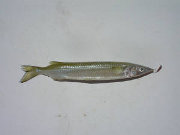
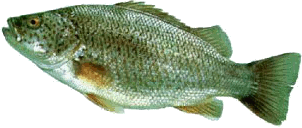
Spangled Perch (Leiopotherapon unicolour)
The Spangled Perch is Australia’s most widely distributed native freshwater fish, being found in all Australian mainland states where it inhabits streams, bores, ponds, billabongs, lakes, dams and any other place that it can inhabit during flood times. It can tolerate water temperatures from 5 degrees to 44 degrees C and is one of the few native freshwater species able to breed prolifically in dams where it spawns at night during summer in shallow areas when water temperature is in the 20 – 26 degree C range.
Commonly found in the 10 – 20cm range, Spangled Perch can grow as long as 33cm with a maximum weight of around 600gms (which can occasionally happen if the density of fish in a particular water body is very low).
This attractive looking fish matures at around 8cm for females and 6cm for males and is usually bluish-silver-grey in colour with brownish-reddish-bronze spots (from which it derives its name) spangled over its head and body.
Angling Hints
The Spangled Perch feeds on a wide variety of foods including fresh water shrimps, small fish and insects in the lake environment it will bite enthusiastically on baits such as worms, local Freshwater Shrimp and dough.
Spangles fight well for their size and provide good fun on light gear using a small baited hook suspended off the bottom. This fish will readily take lures and flies, this includes almost all types. Often these tenacious fighters will take on a lure much larger than themselves. When encountering a school of Spangled Perch large numbers of fish can be caught in a short period of time making them an ideal target for children. Spangles will often take a small hook down deep resulting in its death, if you want to catch and release this species try circle hooks or changing to soft plastics once the bite has started.
Despite a number of small bones being present, Spangled Perch can be one of the sweetest eating of our native fish, more than one fishing trip has be saved by these spectacular fish.


